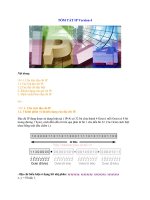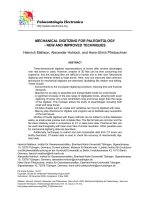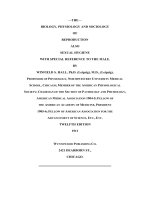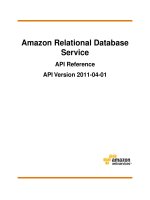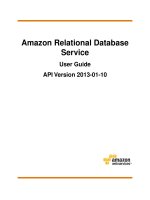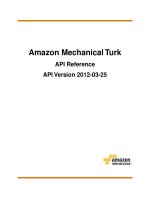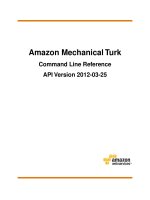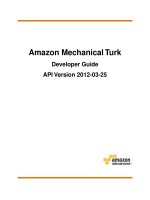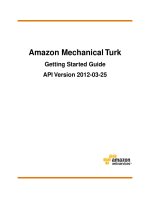Amazon Mechanical Turk Command Line Reference API Version 2012-03-25 doc
Bạn đang xem bản rút gọn của tài liệu. Xem và tải ngay bản đầy đủ của tài liệu tại đây (290.54 KB, 63 trang )
Amazon Mechanical Turk
Command Line Reference
API Version 2012-03-25
Amazon Web Services
Amazon Mechanical Turk Command Line Reference
Amazon Mechanical Turk: Command Line Reference
Amazon Web Services
Copyright © 2013 Amazon Web Services, Inc. and/or its affiliates. All rights reserved.
The following are trademarks of Amazon Web Services, Inc.: Amazon, Amazon Web Services Design, AWS,
Amazon CloudFront, Cloudfront, Amazon DevPay, DynamoDB, ElastiCache, Amazon EC2, Amazon Elastic
Compute Cloud, Amazon Glacier, Kindle, Kindle Fire, AWS Marketplace Design, Mechanical Turk, Amazon
Redshift, Amazon Route 53, Amazon S3, Amazon VPC. In addition, Amazon.com graphics, logos, page
headers, button icons, scripts, and service names are trademarks, or trade dress of Amazon in the U.S.
and/or other countries. Amazon's trademarks and trade dress may not be used in connection with any
product or service that is not Amazon's, in any manner that is likely to cause confusion among customers,
or in any manner that disparages or discredits Amazon.
All other trademarks not owned by Amazon are the property of their respective owners, who may or may
not be affiliated with, connected to, or sponsored by Amazon.
Amazon Mechanical Turk Command Line Reference
Welcome 1
Command Line Reference 2
approveQualificationRequests 3
approveWork 5
assignQualification 8
blockWorker 11
createQualificationType 13
deleteHITs 15
evaluateQualificationRequests 17
extendHITs 20
getBalance 22
getQualificationRequests 24
getResults 26
grantBonus 28
loadHITs 30
makeTemplate 33
rejectQualificationRequests 35
rejectWork 37
resetAccount 39
reviewResults 41
revokeQualification 43
unblockWorker 45
updateHITs 47
updateQualificationScore 49
updateQualificationType 51
Files Used by the Command Line Tools 53
Document History 59
API Version 2012-03-25
4
Amazon Mechanical Turk Command Line Reference
Welcome
This is the Amazon Mechanical Turk Command Line Reference. This guide provides descriptions and
samples and other resources related to the Amazon Mechanical Turk command line interface.The major
sections of this guide are described in the following table.
Amazon Mechanical Turk is a web service that provides an on-demand, scalable, human workforce to
complete jobs that humans can do better than computers, for example, recognizing objects in photos.
For more information about this product go to Amazon Mechanical Turk.
To download the tools go to Amazon Mechanical Turk Command Line Tools.
Alphabetical list of all Amazon Mechanical Turk commands.Commands (p. 2)
Description of the files that the Command Line Tools use.Files Used by the Command Line
Tools (p. 53)
Itemized regions and endpoints for all AWS products.Regions and Endpoints
API Version 2012-03-25
1
Amazon Mechanical Turk Command Line Reference
Command Line Reference
Topics
• approveQualificationRequests (p. 3)
• approveWork (p. 5)
• assignQualification (p. 8)
• blockWorker (p. 11)
• createQualificationType (p. 13)
• deleteHITs (p. 15)
• evaluateQualificationRequests (p. 17)
• extendHITs (p. 20)
• getBalance (p. 22)
• getQualificationRequests (p. 24)
• getResults (p. 26)
• grantBonus (p. 28)
• loadHITs (p. 30)
• makeTemplate (p. 33)
• rejectQualificationRequests (p. 35)
• rejectWork (p. 37)
• resetAccount (p. 39)
• reviewResults (p. 41)
• revokeQualification (p. 43)
• unblockWorker (p. 45)
• updateHITs (p. 47)
• updateQualificationScore (p. 49)
• updateQualificationType (p. 51)
This section describes the commands available in the Command Line Tools.
API Version 2012-03-25
2
Amazon Mechanical Turk Command Line Reference
approveQualificationRequests
Description
The approveQualificationRequests command approves a list of Qualification requests.You can
obtain the list from a call to getQualificationRequests (p. 24).
For information about Qualifications and Qualification requests, see the Amazon Mechanical Turk Developer
Guide.
Arguments
The following table describes the arguments for the approveQualificationRequests command.
RequiredDescriptionName
ConditionalSpecifies a tab delimited text file that contains the list of
Qualification requests to approve. For information about this
file, see The Qualification approve file in Files Used by the
Command Line Tools (p. 53).
Condition: Required if the qualRequest argument is not
specified.
Example: -approvefile
qualification_requests_toapprove.txt
-approvefile
[filename]
NoSpecifies not to prompt for manual confirmation before approving
the requests. Only advanced developers should use this
argument.
Example: -force
-force
NoDisplays the help for this operation.
Example: -help
-help or -h
ConditionalThe Qualification request IDs to approve. Multiple Qualification
request IDs are comma separated.
Condition: Required if the approvefile argument is not
specified.
Example: -qualRequest
TA3ZJBYP2Y7ZJSX2BBN0TZ8ZTM4F6H4ZVQ4DE8FZ
-qualRequest
[Qualification
request ID]
NoRuns this command in the Amazon Mechanical Turk sandbox
for testing.This argument takes precedence even if you specify
the production web site in your mturk.properties file.
Example:-sandbox
-sandbox
NoThe default score to assign for each approved Qualification
request. Any scores defined in the approvefile override this
default.
Example: -score 100
-score [value]
API Version 2012-03-25
3
Amazon Mechanical Turk Command Line Reference
approveQualificationRequests
Example
The following examples for Unix and Windows show how to use the approveQualificationRequests
command. The examples use a file named qualifications.txt that contains 10 requests. Each
request in the file gets a score of 100.
Unix
The following example demonstrates how to call this command from Unix.
./approveQualificationRequests.sh -approvefile qualifications.txt -score 100
Windows
The following example demonstrates how to call this command from Microsoft Windows.
approveQualificationRequests -approvefile qualifications.txt -score 100
Output
These examples produce output similar to the following, but all 10 requests are listed.
You are about to grant 10 qual request(s).
To confirm this operation, please press ENTER (or press Ctrl+C to abort):
[TA3ZJBYP2Y7ZJSX2BBN0TZ8ZTM4F6H4ZVQ4DE8FZ] QualRequest successfully approved
with value (100)
Related Commands
• rejectQualificationRequests (p. 35)
• revokeQualification (p. 43)
API Version 2012-03-25
4
Amazon Mechanical Turk Command Line Reference
Example
approveWork
Description
The approveWork command approves assignments Workers have submitted to Amazon Mechanical
Turk. To specify the assignments to approve you can:
• Obtain the assignment IDs from a call to getResults (p. 26) then call the approveWork command and
use the assignment argument to list the IDs. When you use this argument, you are prompted to
provide optional comments that the Worker can see in the Status section of the web site.
• Use the file that a call the getResults returns as the approvefile argument.You can provide
optional comments for Workers in this file. For information about the format of this file, see Files Used
by the Command Line Tools (p. 53).
• Provide a path to the .success file that a call to loadHITs (p.30) returns.The approveWork command
attempts to approve all assignments for all HITs in the .success file.
When you use this command, it initiates two payments from your Requester account. Amazon Mechanical
Turk pays the reward specified in the HIT to the Worker who submitted the assignment, and also debits
your account for any fees. If your Requester account does not have adequate funds for these payments,
this command returns an error.
Arguments
The following table describes the arguments for the approveWork command.
RequiredDescriptionName
ConditionalThe name of a text file that contains a list of assignment
IDs and, optionally, approval comments. For information
about this file, see The approve file in Files Used by the
Command Line Tools (p. 53).
Condition: Required if neither the -assignment argument
nor the -successfile argument is specified.
Example: -approvefile helloworld_approve.txt
-approvefile
[filename]
ConditionalThe assignment to approve. Multiple assignments IDs are
comma separated.
Condition: Required if neither the -approvefile
argument nor the -successfile argument is specified.
Example: -assignment SYSZH6HTMKFG2ZDECWS0
-assignment
[assignment ID]
NoSpecifies not to prompt for manual confirmation before
performing the operation. Only advanced developers
should use this argument.
Example: -force
-force
NoDisplays the help for this operation.
Example: -help
-help or -h
API Version 2012-03-25
5
Amazon Mechanical Turk Command Line Reference
approveWork
RequiredDescriptionName
NoRuns this command in the Amazon Mechanical Turk
sandbox for testing.This argument takes precedence even
if you specify the production web site in your
mturk.properties file.
Example:-sandbox
-sandbox
ConditionalThe path to the .success file that a call to
loadHITs (p. 30) returned. This argument attempts to
approve all assignments for all HITs in the file. For
information about this file, see The success file in Files
Used by the Command Line Tools (p. 53).
Condition: Required if neither the -approvefile
argument nor the -assignment argument is specified.
Example: -approvefile helloworld_approve.txt
-successfile [path]
Example
The following examples for Unix and Windows show how to use the approveWork command.The
examples approve one assignment in the file approval.txt.
Unix
The following example demonstrates how to call this command from Unix.
./approveWork.sh -approvefile approval.txt
Windows
The following example demonstrates how to call this command from Microsoft Windows.
approveWork -approvefile approval.txt
Output
These examples produce the following output.
Starting approval
[62145TS44X94HHYGW0PZK2CP0E1K9T1PR8Z42WEZ] Assignment successfully approved
for HIT 62145TS44X94HHYGW0PZ
Finished approval
1 assignments approved.
0 assignments failed to be approved.
API Version 2012-03-25
6
Amazon Mechanical Turk Command Line Reference
Example
Related Commands
• rejectWork (p. 37)
API Version 2012-03-25
7
Amazon Mechanical Turk Command Line Reference
Related Commands
assignQualification
Description
The assignQualification command assigns a Qualification to a Worker without the Worker requesting
the Qualification. There are two ways to use this operation:
• Bulk Operation— If you want to assign multiple Qualifications, use this command with a file that
contains the Qualification Type ID and the list of Workers to be assigned the Qualfication.
• Single Assignmentn— You can specify the Qualification Type ID, the Worker, and the assigned
Qualification score on the command line.
Arguments
The following table describes the arguments for the assignQualification command.
RequiredDescriptionName
NoSpecifies not to notify Workers when you have assigned
them the Qualification.
Example: -donotnotify
-donotnotify
NoDisplays the help for this operation.
Example: -help
-help or -h
ConditionalSpecifies the file that contains the Qualification ID you
want to assign to Workers. This file contains a single
Qualification ID.You can find this ID in the .success file
generated after you create the Qualification with the
createQualificationType (p. 13) operation. For
information about this file, see The Qualification ID file in
Files Used by the Command Line Tools (p. 53).
Condition: Required if the qualtypeid argument is not
specified.
Example: -input
qualification.properties.success
-input [filename]
ConditionalSpecifies the Qualification Type ID of the Qualification you
want to assign to the Worker. This ID can be found in the
.success file generated after you create the Qualification
with the > operation.
Condition: Required if the input argument is not specified.
Example: -qualtypeid RWFZTKZ55ZPZXN1C8TDZ
-qualtypeid
[Qualification Type
ID]
NoRuns this command in the Amazon Mechanical Turk
sandbox for testing.This argument takes precedence even
if you specify the production web site in your
mturk.properties file.
Example:-sandbox
-sandbox
API Version 2012-03-25
8
Amazon Mechanical Turk Command Line Reference
assignQualification
RequiredDescriptionName
NoSpecifies the default Qualification score to assign to
Workers.This argument can be used with both the bulk
operation and the single assignment. If this argument is
not specified, and the score has not been defined in the
scorefile, a default score of 1 is used.
Example: -score 100
-score [integer]
ConditionalSpecifies a file which contains a tab delimited list of Worker
IDs and optional Qualification scores to assign to each
Worker. If the score is not specified, a default value of 1
is assigned. For information about this file, see The score
file in Files Used by the Command Line Tools (p. 53).
Condition: Required if the -workerid argument is not
specified.
Example: -scorefile workerstoassign.txt
-scorefile [filename]
ConditionalSpecifies the ID of the Worker you want to assign the
Qualification to.
Condition: Required if the scorefile argument is not
specified.
Example: -workerid A3C4G8DMXFG5PQ
-workerid [Worker ID]
Example
The following examples for Unix and Windows show how to use the AssignQualification command.
The examples demonstrate a single assignment.
Unix
The following example demonstrates how to call this command from Unix.
./assignQualification.sh -qualtypeid RWFZTKZ55ZPZXN1C8TDZ -workerid
A3C4G8DMXFG5PQ -score 100
Windows
The following example demonstrates how to call this command from Microsoft Windows.
assignQualification -qualtypeid RWFZTKZ55ZPZXN1C8TDZ -workerid A3C4G8DMXFG5PQ
-score 100
Output
These examples produce the following output.
API Version 2012-03-25
9
Amazon Mechanical Turk Command Line Reference
Example
Assigned qualification RWFZTKZ55ZPZXN1C8TDZ to A3C4G8DMXFG5PQ with value 100
Related Commands
• createQualificationType (p. 13)
API Version 2012-03-25
10
Amazon Mechanical Turk Command Line Reference
Related Commands
blockWorker
Description
The blockWorker command blocks a Worker from working on your HITs.
Arguments
The following table describes the arguments for the blockWorker command.
RequiredDescriptionName
NoDisplays the help for this operation.
Example: -help
-help or -h
YesThe reason why the Worker is being blocked.This reason
is logged in our system for auditing purposes and can be
used to determine if corrective action against the Worker
is necessary. Enclose the reason string in quotation marks.
Example:-reason "After several warnings, the
Worker continued to submit answers without
reading the instructions carefully."
-reason [string]
NoRuns this command in the Amazon Mechanical Turk
sandbox for testing.This argument takes precedence even
if you specify the production web site in your
mturk.properties file.
Example:-sandbox
-sandbox
YesThe ID of the Worker you want to block.
Example: -workerid A3C4G8DMXFG5PQ
-workerid [Worker ID]
Example
The following examples for Unix and Windows show how to use the blockWorker command.
Unix
The following example demonstrates how to call this command from Unix.You must write this command
on a single line. It is divided into multiple lines in this example for readability.
./blockWorker.sh -workerid A3C4G8DMXFG5PQ -reason "After several warnings, the
Worker continued to
submit answers without reading the instructions carefully."
Windows
The following example demonstrates how to call this command from Microsoft Windows.You should write
this command on a single line. It is divided into multiple lines in this example for readability.
API Version 2012-03-25
11
Amazon Mechanical Turk Command Line Reference
blockWorker
blockWorker -workerid A3C4G8DMXFG5PQ -reason "After several warnings, the
Worker continued to
submit answers without reading the instructions carefully."
Output
These examples produce the following ouput.
Blocked A3C4G8DMXFG5PQ with reason: After several warnings, the Worker continued
to submit answers without reading the instructions carefully.
Related Commands
• unblockWorker (p. 45)
API Version 2012-03-25
12
Amazon Mechanical Turk Command Line Reference
Output
createQualificationType
Description
The createQualificationType command creates a Qualification that can be used for your HITs.You
can use the arguments to specify files that contain the Qualification test and the answers for the test.You
can also create a Qualification that does not require a test. For more information about Qualifications,
see the Amazon Mechanical Turk Developer Guide.
Arguments
The following table describes the arguments for the createQualificationType command.
RequiredDescriptionName
NoSpecifies the file that contains the answers for the
Qualification test. If this argument is omitted, you create
a Qualification that does not require a test. For information
about this file, see The Qualification answer file in Files
Used by the Command Line Tools (p. 53).
Example: -answer qualification.answers
-answer [filename]
NoDisplays the help for this operation.
Example: -help
-help or -h
NoSpecifies that Workers can only request the Qualification
once.
Example: -noretry
-noretry
YesSpecifies the Qualification properties file. For information
about this file, see The Qualification properties file in Files
Used by the Command Line Tools (p. 53).
Example:-properties qualification.properties
-properties
[filename]
NoSpecifies the Qualification question file that contains the
Qualification test. For information about this file, see The
Qualification question file in Files Used by the Command
Line Tools (p. 53).
Example:-question qualification.question
-question [filename]
NoRuns this command in the Amazon Mechanical Turk
sandbox for testing.This argument takes precedence even
if you specify the production web site in your
mturk.properties file.
Example:-sandbox
-sandbox
Example
The following examples for Unix and Windows show how to use the createQualificationType
command. The examples use the property file qualification.properties and the question file
qualification.question. These examples create the qualification in the test environment.
API Version 2012-03-25
13
Amazon Mechanical Turk Command Line Reference
createQualificationType
Unix
The following example demonstrates how to call this command from Unix.
.createQualificationType.sh -properties qualification.properties -question
qualification.question -noretry -sandbox
Windows
The following example demonstrates how to call this command from Microsoft Windows.
createQualificationType -properties qualification.properties -question qualific
ation.question -noretry -sandbox
Output
If this command completes successfully, it creates a .success file with the name specified in the
-properties argument. For this example, the file is named qualification.properties.success.
This file contains the Qualification Type ID of the newly created Qualification.This command also produces
ouput similar to the following.
Created qualification type: KYJ4GZZ5G3M6TDCEWYF0
You can take the test here:
tionId=KYJ4GZZ5G3M6TDCEWYF0
Related Commands
• getQualificationRequests (p. 24)
API Version 2012-03-25
14
Amazon Mechanical Turk Command Line Reference
Output
deleteHITs
Description
The deleteHITs command deletes your HITs from Amazon Mechanical Turk. Use the arguments to
specify how to handle assignments that have not been approved or are still available to Workers.You
specify the HITs to delete in a file, which you generate as the output of getResults (p. 26).
Arguments
The following table describes the arguments for the deleteHITs command.
RequiredDescriptionName
NoAutomatically approves any assignments that have been
submitted and have not been approved or rejected.
Assignments that are in the review or reviewing states
cannot be deleted.
Example: -approve
-approve
NoAutomatically expires any HITs that are still available to
Workers on Amazon Mechanical Turk. Live HITs cannot
be deleted.
Example: -expire
-expire
NoSpecifies not to prompt for manual confirmation before
deleting the HITs. Only advanced developers should use
this argument.
Example: -force
-force
NoDisplays the help for this operation.
Example:-help
-help or -h
NoRuns this command in the Amazon Mechanical Turk
sandbox for testing.This argument takes precedence even
if you specify the production web site in your
mturk.properties file.
Example:-sandbox
-sandbox
YesSpecifies the success file that contains the HITs to be
deleted. For information about this file, see The success
file in Files Used by the Command Line Tools (p. 53).
Example: -successfile helloworld.success
-successfile
[filename]
Example
The following examples for Unix and Windows show how to use the deleteHITs command.This example
deletes five assignments in the file survey.success. If any HITs in the file have been submitted, this
example approves them. If any HITs are still available, this example expires them.
API Version 2012-03-25
15
Amazon Mechanical Turk Command Line Reference
deleteHITs
Windows
The following example demonstrates how to call this command from Microsoft Windows.
deleteHITs -successfile survey.success -approve -expire
Unix
The following example demonstrates how to call this command from Unix.
./deleteHITs.sh -successfile survey.success -approve -expire
Output
These examples produce the following output.
Starting to delete HITs
You are about to delete 5 HITs.
To confirm this operation, please press ENTER (or press Ctrl+C to abort):
[X1F6ZRZ8GW1ETS561XR0] Successfully deleted HIT (1/5)
[8X3GV2YWKAZZR9ZCEYB0] Successfully deleted HIT (2/5)
[YA3ZKSYWVWMWZ053TYKZ] Successfully deleted HIT (3/5)
[DYBZQP51T3VEKHXXFWR0] Successfully deleted HIT (4/5)
[F09PWRZ81WDEW5Z2FZJZ] Successfully deleted HIT (5/5)
Finished to delete HITs
5 HITs have been deleted or were deleted previously.
0 errors occured.
API Version 2012-03-25
16
Amazon Mechanical Turk Command Line Reference
Output
evaluateQualificationRequests
Description
The evaluateQualificationRequests command evaluates the answers submitted by Workers so
you can approve or reject the Qualification requests.You can use the preview argument to view the
results before you approve them. If you run this command without the preview argument, the request
is approved or rejected.
This command uses an answer key file to automatically review Workers' test results and determine if the
Qualification request should be approved or rejected.
Tip
This allows you to specify free text answers that can be automatically processed.This overcomes
a limitation of the Amazon Mechanical Turk system where FreeTextAnswer type answers cannot
be auto-graded.
All questions must be answered correctly in order for the Qualification request to be approved. A
Qualification score of 100 is assigned for approvals.
For more information about Qualifications, see the Amazon Mechanical Turk Developer Guide.
Arguments
The following table describes the arguments for the evaluateQualificationRequests command.
RequiredDescriptionName
YesSpecifies the file that contains the answer key. For
information about this file, see The Qualification answer
key file in Files Used by the Command Line Tools (p. 53).
Example: -answers qualification.answerkey
-answers [filename]
NoDisplays the help for this operation.
Example: -help
-help or -h
ConditionalSpecifies the file that contains the Qualification ID you
want to assign to Workers. This file contains a single
Qualification ID. This ID is found in a .success file
generated after you create the Qualification with the
createQualificationType (p. 13) operation. For information
about this file, see The Qualification ID file in Files Used
by the Command Line Tools (p. 53).
Condition: Required if the qualtypeid argument is not
specified.
Example: -input
qualification.properties.success
-input [filename]
NoSpecifies that you want to preview the outcome of the
Qualification request evaluations before submitting the
decisions to Amazon Mechanical Turk.
Example: -preview
-preview
API Version 2012-03-25
17
Amazon Mechanical Turk Command Line Reference
evaluateQualificationRequests
RequiredDescriptionName
ConditionalSpecifies the Qualification Type ID for which to evaluate
the Qualification requests.
Condition: Required if the input argument is not specified.
Example: -qualtypeid RWFZTKZ55ZPZXN1C8TDZ
-qualtypeid
[Qualification Type
ID]
NoRuns this command in the Amazon Mechanical Turk
sandbox for testing.This argument takes precedence even
if you specify the production web site in your
mturk.properties file.
Example:-sandbox
-sandbox
Example
The following examples for Unix and Windows show how to use the evaluateQualificationRequests
command. These examples preview the results.
Unix
The following example demonstrates how to call this command from Unix.
./evaluateQualificationRequests.sh -answers qualification.answerkey -qualtypeid
RWFZTKZ55ZPZXN1C8TDZ -preview
Windows
The following example demonstrates how to call this command from Microsoft Windows.
evaluateQualificationRequests -answers qualification.answerkey -qualtypeid RW
FZTKZ55ZPZXN1C8TDZ -preview
Output
These examples produce the following output.
Preview flag is set. Qualification requests will not be approved or rejected.
[Worker A3C4G8DMFSG5PQ]
Question question1:CORRECT [The answer key 'false' matches the given answer
'false']
Question question2:CORRECT [The answer key 'true' matches the given answer
'true']
Question question3:CORRECT [The answer key '1' matches the given answer '1']
Worker A3C4G8DMFSG5PQ has PASSED your test and scored 100
API Version 2012-03-25
18
Amazon Mechanical Turk Command Line Reference
Example
Related Commands
• getQualificationRequests (p. 24)
API Version 2012-03-25
19
Amazon Mechanical Turk Command Line Reference
Related Commands
extendHITs
Description
The extendHITs command extends the expiration date or increases the maximum number of assignments
for all HITs in the specified -successfile. If you extend the expiration date, and the HIT has not expired,
the new expiration date is the existing date plus the amount of time specified. If the HIT has already
expired, the new expiration date is the current time plus the amount of time specified. If you add additional
assignments, you must be sure that you have enough funds to pay for the assignments.
Arguments
The following table describes the arguments for the extendHITs command.
RequiredDescriptionName
NoThe number of assignments to add to the HITs.
Example: -assignments 12
-assignments
[integer]
NoDisplays the help for this operation.
Example: -help
-help or -h
NoThe amount of time, in hours, by which to extend the
expiration date of the HITs.
Example: -hours 12
-hours [integer]
NoRuns this command in the Amazon Mechanical Turk
sandbox. This argument takes precedence even if you
specify the production web site in your
mturk.properties file.
Example:-sandbox
-sandbox
YesThe path to the .success file that contains the HITs to
extend. This is the file that loadHITs (p. 30) returns. For
information about this file, see The success file in Files
Used by the Command Line Tools (p. 53).
Example:-successfile
\mysurvey\mysurvey.success
-successfile
[filename]
Example
The following examples for Unix and Windows show how to use the extendHITs command.These
examples add four assignments and three hours to the five HITs in the .success file.
Unix
The following example demonstrates how to call this command from Unix.
./extendHITs.sh -successfile \mysurvey\mysurvey.success -assignments 4 -hours
API Version 2012-03-25
20
Amazon Mechanical Turk Command Line Reference
extendHITs
3
Windows
The following example demonstrates how to call this command from Microsoft Windows.
extendHITs -successfile \mysurvey\mysurvey.success -assignments 4 -hours 3
Output
This example produces output similar to the following.
Starting to extend HITs
[0YFZ2TYJF3HZPGZV4Z40] Successfully extended HIT (1/5)
[4GMZSHZKKK9WT9M9XWA0] Successfully extended HIT (2/5)
[XYTZY0YK1W2ZTCZM9Z80] Successfully extended HIT (3/5)
[RZGZZ4Z6GXKTV5DX81B0] Successfully extended HIT (4/5)
[M26ZN61JMT9E4MG0M94Z] Successfully extended HIT (5/5)
Finished to extend HITs
5 HITs have been extended (added 4 assignment(s), 3 hour(s))
0 HITs failed to be extended.
API Version 2012-03-25
21
Amazon Mechanical Turk Command Line Reference
Output
